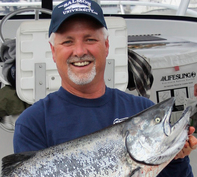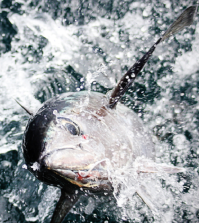Tuna 101

Each week one of the Salmon University experts answers reader questions in our “Ask a Pro” feature. This week’s question is answered by Kevin Lanier. Submit your own question here.
Q: I have been fishing Westport and Ilwaco in Washington for years and have always wanted to head out a bit further for tuna. Well I’m going to do it this year and was wondering what kind of set-up you use? I plan on trolling to find the fish and then have a setup for live bait ready to go. Thanks – Adam
A: That is a great question as I know many people wonder the same thing. I would recommend your first trip be on a charter and it should be on one of the smaller six-pack boats because they will fish more like you will on your boat. This will save you a lot of money in the long run. Also there are a number of tuna seminars offered around the area. Try to attend one of them.
First off, for trolling, most guys just use their halibut gear to troll for tuna: a heavy weight rod up to a 100-lb class and a high capacity reel like a Penn 114 or 116. I DO NOT recommend a level wind reel. Tuna run so hard and fast after the strike that it will cause the level wind bar to jam thus causing a reel failure. I troll four rods. Two out the stern and two out each side. I like cedar plugs or clones for the side baits and an XRap diving plug along with another cedar plug off the stern. Keep one of the stern baits within ten feet of the boat. Make sure you have your “clickers” turned on or you might get spooled before you know it. Look for 59 degree or higher water temperature and good blue water. I troll in an S pattern and your speed should be 6 miles per hour. Hang on!
For live bait you will need a bait tank with good water flow in a round or oval shape. You will want a rod with a good back bone and a good reel. I use the Avet SX reel and there are a number of companies that make really good jig or bait rods 7 to 8 feet in length. You will need to use 30 pound monofilament line or 50 pound braided line. If you use braid, tie a 6 to 8 foot piece of 30 pound fluoro carbon line to the end of the braid. Use a #1 or #4 live bait hook. After you hook the trolled tuna, stop the boat and toss a small scoop of live anchovies in the water, have one person hook an anchovy and toss it in the water, have the reel in free spool with your thumb on the reel but let the anchovy swim away from the boat. When the tuna grabs the bait count to 5, engage the drag, then HANG ON!
There is so much to cover about Tuna fishing that I can’t do it justice here. I would suggest not trying to start out doing it all. Maybe do a trip or two just trolling. Make sure you pay really close attention to the weather and make wise choices on going or not. I personally would not suggest going out in a boat less than 24 feet in length. You will need to take plenty of ice with you, about 5 pounds per tuna, because they are warm when you catch them and you must cool them down quickly to retain the quality of the meat.
If you are coming to Westport stop by my store and I will show you most of the gear we use and talk tuna fishing.







